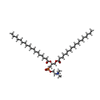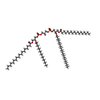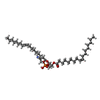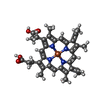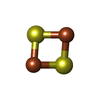[English] 日本語
 Yorodumi
Yorodumi- EMDB-15868: Cryo-EM structure of cytochrome bc1 complex (complex-III) from re... -
+ Open data
Open data
- Basic information
Basic information
| Entry |  | |||||||||||||||
|---|---|---|---|---|---|---|---|---|---|---|---|---|---|---|---|---|
| Title | Cryo-EM structure of cytochrome bc1 complex (complex-III) from respiratory supercomplex of Tetrahymena thermophila | |||||||||||||||
 Map data Map data | Sharpened mask refined map | |||||||||||||||
 Sample Sample |
| |||||||||||||||
| Function / homology |  Function and homology information Function and homology informationquinol-cytochrome-c reductase / protein processing involved in protein targeting to mitochondrion / : / ubiquinol-cytochrome-c reductase activity / mitochondrial electron transport, ubiquinol to cytochrome c / : / metalloendopeptidase activity / 2 iron, 2 sulfur cluster binding / mitochondrial inner membrane / oxidoreductase activity ...quinol-cytochrome-c reductase / protein processing involved in protein targeting to mitochondrion / : / ubiquinol-cytochrome-c reductase activity / mitochondrial electron transport, ubiquinol to cytochrome c / : / metalloendopeptidase activity / 2 iron, 2 sulfur cluster binding / mitochondrial inner membrane / oxidoreductase activity / electron transfer activity / heme binding / mitochondrion / membrane / metal ion binding / plasma membrane Similarity search - Function | |||||||||||||||
| Biological species |   Tetrahymena thermophila SB210 (eukaryote) Tetrahymena thermophila SB210 (eukaryote) | |||||||||||||||
| Method | single particle reconstruction / cryo EM / Resolution: 2.8 Å | |||||||||||||||
 Authors Authors | Muhleip A / Kock Flygaard R / Amunts A | |||||||||||||||
| Funding support |  Sweden, European Union, 4 items Sweden, European Union, 4 items
| |||||||||||||||
 Citation Citation |  Journal: Nature / Year: 2023 Journal: Nature / Year: 2023Title: Structural basis of mitochondrial membrane bending by the I-II-III-IV supercomplex. Authors: Alexander Mühleip / Rasmus Kock Flygaard / Rozbeh Baradaran / Outi Haapanen / Thomas Gruhl / Victor Tobiasson / Amandine Maréchal / Vivek Sharma / Alexey Amunts /      Abstract: Mitochondrial energy conversion requires an intricate architecture of the inner mitochondrial membrane. Here we show that a supercomplex containing all four respiratory chain components contributes ...Mitochondrial energy conversion requires an intricate architecture of the inner mitochondrial membrane. Here we show that a supercomplex containing all four respiratory chain components contributes to membrane curvature induction in ciliates. We report cryo-electron microscopy and cryo-tomography structures of the supercomplex that comprises 150 different proteins and 311 bound lipids, forming a stable 5.8-MDa assembly. Owing to subunit acquisition and extension, complex I associates with a complex IV dimer, generating a wedge-shaped gap that serves as a binding site for complex II. Together with a tilted complex III dimer association, it results in a curved membrane region. Using molecular dynamics simulations, we demonstrate that the divergent supercomplex actively contributes to the membrane curvature induction and tubulation of cristae. Our findings highlight how the evolution of protein subunits of respiratory complexes has led to the I-II-III-IV supercomplex that contributes to the shaping of the bioenergetic membrane, thereby enabling its functional specialization. #1:  Journal: Biorxiv / Year: 2022 Journal: Biorxiv / Year: 2022Title: Structural basis of mitochondrial membrane bending by I-II-III2-IV2 supercomplex Authors: Muhleip A / Flygaard RK / Haapanen O / Baradaran R / Gruhl T / Tobiasson V / Marechal A / Sharma V / Amunts A | |||||||||||||||
| History |
|
- Structure visualization
Structure visualization
| Supplemental images |
|---|
- Downloads & links
Downloads & links
-EMDB archive
| Map data |  emd_15868.map.gz emd_15868.map.gz | 398.1 MB |  EMDB map data format EMDB map data format | |
|---|---|---|---|---|
| Header (meta data) |  emd-15868-v30.xml emd-15868-v30.xml emd-15868.xml emd-15868.xml | 35.9 KB 35.9 KB | Display Display |  EMDB header EMDB header |
| FSC (resolution estimation) |  emd_15868_fsc.xml emd_15868_fsc.xml | 16.5 KB | Display |  FSC data file FSC data file |
| Images |  emd_15868.png emd_15868.png | 79.3 KB | ||
| Masks |  emd_15868_msk_1.map emd_15868_msk_1.map | 421.9 MB |  Mask map Mask map | |
| Others |  emd_15868_additional_1.map.gz emd_15868_additional_1.map.gz emd_15868_additional_2.map.gz emd_15868_additional_2.map.gz emd_15868_additional_3.map.gz emd_15868_additional_3.map.gz emd_15868_half_map_1.map.gz emd_15868_half_map_1.map.gz emd_15868_half_map_2.map.gz emd_15868_half_map_2.map.gz | 213.4 MB 1.8 MB 1.8 MB 390.9 MB 390.9 MB | ||
| Archive directory |  http://ftp.pdbj.org/pub/emdb/structures/EMD-15868 http://ftp.pdbj.org/pub/emdb/structures/EMD-15868 ftp://ftp.pdbj.org/pub/emdb/structures/EMD-15868 ftp://ftp.pdbj.org/pub/emdb/structures/EMD-15868 | HTTPS FTP |
-Validation report
| Summary document |  emd_15868_validation.pdf.gz emd_15868_validation.pdf.gz | 1.2 MB | Display |  EMDB validaton report EMDB validaton report |
|---|---|---|---|---|
| Full document |  emd_15868_full_validation.pdf.gz emd_15868_full_validation.pdf.gz | 1.2 MB | Display | |
| Data in XML |  emd_15868_validation.xml.gz emd_15868_validation.xml.gz | 22.5 KB | Display | |
| Data in CIF |  emd_15868_validation.cif.gz emd_15868_validation.cif.gz | 29.8 KB | Display | |
| Arichive directory |  https://ftp.pdbj.org/pub/emdb/validation_reports/EMD-15868 https://ftp.pdbj.org/pub/emdb/validation_reports/EMD-15868 ftp://ftp.pdbj.org/pub/emdb/validation_reports/EMD-15868 ftp://ftp.pdbj.org/pub/emdb/validation_reports/EMD-15868 | HTTPS FTP |
-Related structure data
| Related structure data |  8b6jMC  8b6fC  8b6gC 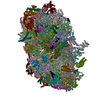 8b6hC M: atomic model generated by this map C: citing same article ( |
|---|---|
| Similar structure data | Similarity search - Function & homology  F&H Search F&H Search |
- Links
Links
| EMDB pages |  EMDB (EBI/PDBe) / EMDB (EBI/PDBe) /  EMDataResource EMDataResource |
|---|---|
| Related items in Molecule of the Month |
- Map
Map
| File |  Download / File: emd_15868.map.gz / Format: CCP4 / Size: 421.9 MB / Type: IMAGE STORED AS FLOATING POINT NUMBER (4 BYTES) Download / File: emd_15868.map.gz / Format: CCP4 / Size: 421.9 MB / Type: IMAGE STORED AS FLOATING POINT NUMBER (4 BYTES) | ||||||||||||||||||||||||||||||||||||
|---|---|---|---|---|---|---|---|---|---|---|---|---|---|---|---|---|---|---|---|---|---|---|---|---|---|---|---|---|---|---|---|---|---|---|---|---|---|
| Annotation | Sharpened mask refined map | ||||||||||||||||||||||||||||||||||||
| Projections & slices | Image control
Images are generated by Spider. | ||||||||||||||||||||||||||||||||||||
| Voxel size | X=Y=Z: 1.25 Å | ||||||||||||||||||||||||||||||||||||
| Density |
| ||||||||||||||||||||||||||||||||||||
| Symmetry | Space group: 1 | ||||||||||||||||||||||||||||||||||||
| Details | EMDB XML:
|
-Supplemental data
-Mask #1
| File |  emd_15868_msk_1.map emd_15868_msk_1.map | ||||||||||||
|---|---|---|---|---|---|---|---|---|---|---|---|---|---|
| Projections & Slices |
| ||||||||||||
| Density Histograms |
-Additional map: Unsharpened mask refined map
| File | emd_15868_additional_1.map | ||||||||||||
|---|---|---|---|---|---|---|---|---|---|---|---|---|---|
| Annotation | Unsharpened mask refined map | ||||||||||||
| Projections & Slices |
| ||||||||||||
| Density Histograms |
-Additional map: Rieske B-state map from focused classification
| File | emd_15868_additional_2.map | ||||||||||||
|---|---|---|---|---|---|---|---|---|---|---|---|---|---|
| Annotation | Rieske B-state map from focused classification | ||||||||||||
| Projections & Slices |
| ||||||||||||
| Density Histograms |
-Additional map: Rieske C-state map from focused classification
| File | emd_15868_additional_3.map | ||||||||||||
|---|---|---|---|---|---|---|---|---|---|---|---|---|---|
| Annotation | Rieske C-state map from focused classification | ||||||||||||
| Projections & Slices |
| ||||||||||||
| Density Histograms |
-Half map: Half-map A
| File | emd_15868_half_map_1.map | ||||||||||||
|---|---|---|---|---|---|---|---|---|---|---|---|---|---|
| Annotation | Half-map A | ||||||||||||
| Projections & Slices |
| ||||||||||||
| Density Histograms |
-Half map: Half-map B
| File | emd_15868_half_map_2.map | ||||||||||||
|---|---|---|---|---|---|---|---|---|---|---|---|---|---|
| Annotation | Half-map B | ||||||||||||
| Projections & Slices |
| ||||||||||||
| Density Histograms |
- Sample components
Sample components
+Entire : Dimeric cytochrome bc1 complex (complex-III2)
+Supramolecule #1: Dimeric cytochrome bc1 complex (complex-III2)
+Macromolecule #1: Peptidase M16 inactive domain protein
+Macromolecule #2: M16 family peptidase, putative
+Macromolecule #3: Apocytochrome b
+Macromolecule #4: Cytochrome protein c1
+Macromolecule #5: Rieske iron-sulfur protein, ubiquinol-cytochrome C reductase iron...
+Macromolecule #6: Ubiquinol-cytochrome C reductase hinge protein
+Macromolecule #7: UQCRTT1
+Macromolecule #8: Transmembrane protein, putative
+Macromolecule #9: Transmembrane protein, putative
+Macromolecule #10: UQCRTT3/UP1
+Macromolecule #11: Transmembrane protein, putative
+Macromolecule #12: UQCRTT2
+Macromolecule #13: 1,2-DIACYL-SN-GLYCERO-3-PHOSPHOCHOLINE
+Macromolecule #14: PROTOPORPHYRIN IX CONTAINING FE
+Macromolecule #15: CARDIOLIPIN
+Macromolecule #16: Ubiquinone-8
+Macromolecule #17: 1,2-dioleoyl-sn-glycero-3-phosphoethanolamine
+Macromolecule #18: HEME C
+Macromolecule #19: FE2/S2 (INORGANIC) CLUSTER
-Experimental details
-Structure determination
| Method | cryo EM |
|---|---|
 Processing Processing | single particle reconstruction |
| Aggregation state | particle |
- Sample preparation
Sample preparation
| Buffer | pH: 7.5 |
|---|---|
| Vitrification | Cryogen name: ETHANE |
- Electron microscopy
Electron microscopy
| Microscope | FEI TITAN KRIOS |
|---|---|
| Image recording | Film or detector model: GATAN K2 QUANTUM (4k x 4k) / Average electron dose: 25.66 e/Å2 |
| Electron beam | Acceleration voltage: 300 kV / Electron source:  FIELD EMISSION GUN FIELD EMISSION GUN |
| Electron optics | Illumination mode: FLOOD BEAM / Imaging mode: BRIGHT FIELD / Nominal defocus max: 2.6 µm / Nominal defocus min: 0.6 µm |
| Experimental equipment |  Model: Titan Krios / Image courtesy: FEI Company |
 Movie
Movie Controller
Controller


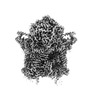










 Z (Sec.)
Z (Sec.) Y (Row.)
Y (Row.) X (Col.)
X (Col.)




































































